Introduction
Yesterday’s high-end is the new midrange we like to say. The Nokia C6 has almost exactly the same features as the Nokia N97 mini but hangs a big Sale sign. Time to shop for high-end features off high street.
The C-series are trying to distill the Nokia knowledge and experience into a lineup of simple and affordable phones. There’s a bit of everything there: from cheap entry-level handsets to smartphones that border on the Eseries and Nseries.




Nokia C6 official photos
And Nokia is in no mood to relax it seems. The C-series went from one to six in almost no time, and a C7 may as well be on the way. Now, technically there is no number four –but that’s one number Nokia isn’t really fond of. Anyway, if there ever was to be a C4 we just know it would’ve been dynamite.
Being a C-series phone, you can expect the C6 to be a decent all-rounder. And it is. There’re no mind-blowing features but there’s nothing major missing either. And what isn’t there (e.g. document editing) can be easily fixed with the right app.
Key features
- 3.2" 16M-color resistive touchscreen of 640 x 360 pixel resolution
- Symbian OS 9.4 with S60 5th edition UI
- Slide-out four-row full QWERTY keyboard
- ARM 11 434MHz CPU
- Quad-band GSM/GPRS/EDGE
- Tri-band 3G with 3.6Mbps HSDPA support
- 5 megapixel autofocus camera with LED flash and VGA@30fps video recording
- Wi-Fi and stereo Bluetooth v2.1
- GPS with A-GPS and free lifetime voice-guided navigation license
- microSD card (16 GB supported, 2GB included)
- Built-in accelerometer for display auto-rotation, turn-to-mute
- 3.5 mm audio jack
- Smart dialing
- Stereo FM Radio with RDS
- microUSB port
- Web browser has Flash support
- Good audio quality
- Office document viewer
Main disadvantages
- Display performs poorly under direct sunlight
- The S60 touch UI is clunky
- Doesn’t charge off USB
- Average loudspeaker performance
- No DivX or XviD video support out-of-the-box
- No office document editing (without a paid upgrade)
- No camera lens protection
These days, communication over text-based channels is bigger than ever – SMS, email, Twitter, Facebook, IM to name but a few. And they have a certain advantage over voice calling. They’re cheap, or absolutely free, even when you’re reaching someone on another continent.
Text-based messaging is important. But as good as touchscreen input methods are getting (especially with clever tricks such as Swype), there’s just no match for a good hardware QWERTY keyboard.
There isn’t as much pressure on the Nokia C6 as there was on the N97 duo. The C6 is not a top-tier device – it’s a high volume device instead. You know, the one most people end up buying after deciding that the dream device costs too much.
So, how close exactly is the Nokia C6 to the N97 mini? Jump to the next page to find out how the hardware of both stacks up.
Retail package
The retail box covers the essentials and leaves it at that. You have the charger plus a (short) data cable. The charger is absolutely tiny – a good thing since you’ll have to carry it when you travel, as the Nokia C6 doesn’t charge off USB.


The included headset is one-piece, so replacing the headphones while keeping the remote is not an option. There isn't a stylus included in the Nokia C6 retail package but we don’t miss that too much.
A 2GB microSD card is supplied, but keep in mind that unlike the Nokia N97 and N97 mini, the C6 doesn’t have much of a built-in memory. You can use a bigger microSD card to compensate, the C6 supports cards of up to 16GB.
Nokia C6 spins 360-degrees
The Nokia C6 is somewhere between the Nokia N97 and the N97 mini in terms of size. It’s got a 3.2” touchscreen just like the N97 mini and the front face dimensions are about equal, too.
However, the C6 stands at 113 x 53 x 16.8 mm and weighs a hefty 150 g. It’s quite a bit thicker than the mini (and heavier). That’s almost a full millimeter thicker too than the regular N97.



Unlike the N97 mini, the Nokia C6 has room on the keyboard for a D-pad (like the big N97). The downside here is that while the keys on both keyboards are about the same size, the ones on the C6 keyboard are cramped together.
Design and construction
It’s more than obvious the C6 is similar to the N97 in many ways. When closed however, it is a dead ringer for the Nokia 5800 XpressMusic, the phone which very much set the overall look and feel for many of Nokia’s touch phones. Sliding it open is where the comparisons with the Nokia N97 duo begin.
And it should be where they end, at least regarding the keyboard itself. In many ways, it’s much closer to the Nokia E75 – no tilting display and a four-row QWERTY with no margin between the keys.
The C6 has a 3.2” resistive touchscreen of nHD resolution – the popular choice among Symbian phones. The 360 x 640 pixel resolution is quite right for that size, though obviously no match for the pixel-dense screens of high-end touch phones. The response of the resistive display is good enough, but not as good as capacitive displays are.
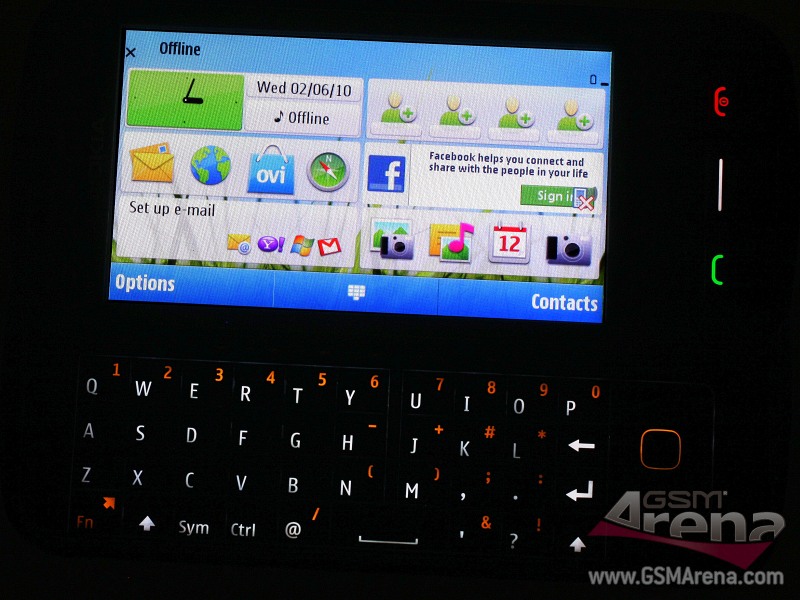
The 3.2" display is pretty good
The sunlight legibility on the other hand is poor – taking the Nokia C6 outside on a sunny day means you’ll have to shield the display against bright sunlight if you want to see anything on the screen. That’s quite unlike Nokia N97.
Bellow the screen is the usual trio of green and red receiver keys and the menu key. The menu key is placed in the middle, like on the Nokia 5800. We liked the N97 solution better though of putting it on the side, skewed 45 degrees. That made the key equally easy to use in both portrait and landscape orientation. With the Nokia C6, you have to aim right between the call keys, but you’ll get used to it quickly.
There’s a lot going on above the screen with a bunch of sensors placed around the earpiece at the center. The C6 has an ambient light and a proximity sensor, and a dedicated QVGA video-call camera.

A couple of sensors, a video-call camera and the earpiece are on top
The controls on the sides of the Nokia C6 .On the right side, from top to bottom there’re the volume rocker, the lock/hold key and the shutter key. The left side features the protected microSD card slot.

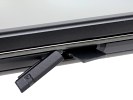
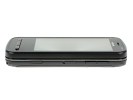

The sides of the Nokia C6
Comfortable QWERTY keyboard
So far the C6 basically with a better camera. The major feature that the Nokia C6 has over its older cousin, however, is the QWERTY keyboard. The screen doesn’t tilt like it did on the N97 duo, but you can still comfortably hold the keyboard and look at the screen head on.
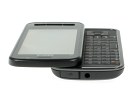


Opening the Nokia C6 – no tilting action here
The keyboard is comparable to the one on the Motorola MILESTONE (or DROID in the US) – and that’s quite a compliment. The keys are about the same size, but not as flat and with good feedback, making the keyboard very comfortable to use. The top row is somewhat cramped against the top half of the slider though.

The four-row QWERTY on the Nokia C6 has more keys and fewer symbols per key compared to the three-row keyboard of the N97, so occasions where you need to use the function key are rarer.
The backlighting of the keyboard is strong and quite even, so you won’t have problems using it in the dark.
The keyboard is accompanied by a D-pad – it’s on the right side this time rather than the left like it was on the N97. The Nokia N97 mini omitted the D-pad to leave more room for the rest of the keyboard. On the other hand, the wider borders between the keys on the N97 mini improved the typing experience.
We compared the C6 to the Nokia E75, another keyboard we quite liked. The two keyboards are very similar, however the keys on the C6 are smaller – because of the D-pad.
Decent 5 megapixel camera
Nokia C6 has a 5 MP camera for a maximum image resolution of 2592x1944 pixels. The camera UI is similar to what you get in the 5800 XpressMusic, the N97 or the N97 mini.
All the settings are squeezed in a combined menu, except for the flash, which has its own dedicated shortcut. We understand that a tabular layout isn't the easiest of things to do on this kind of device but some of the more important features could have had their own shortcuts too.



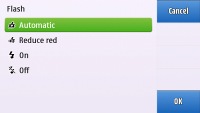
At least the range of settings that the Nokia C6 offers is extensive enough: from manual white balance and ISO to exposure compensation, sharpness and contrast. Various effects are also at hand, labeled as Color Tones.
Geotagging is enabled but the Nokia C6 omits some of the modern features competing manufacturers are using, such as face detection, smile detection and even blink prevention.
The viewfinder on the Nokia C6 doesn't occupy the whole screen - a bar on the right is reserved for the touch controls. You have a settings button that launches a semi-transparent overlay of all available shooting options, a dedicated Flash button, an on-screen shutter key and finally, the Options menu key.
The on-screen shutter key seems absolutely redundant – it doesn't have a half press/full press action to properly handle auto focus. It would've been way better to have a Quick Settings button instead.
Image quality
The picture quality is pretty decent by our books. First of all, resolved detail is more than adequate. Noise reduction finds a good balance between keeping noise levels low and preserving fine detail. There is no purple fringing whatsoever and the white balance and auto ISO settings are well tweaked. Photos have good contrast and accurate colors.
And there go one photo samples from the C6 camera.

Final words
It may look like the same old same old prima facie, but that's exactly what the C series are all about. They are just not the kind of phones to set the place on fire. It's a lineup aimed at the mass market and it doesn't need inspiration and creativity when a couple of tried and tested recipes will do.
The C series are the melting pot for designs, forms and features that are proven to work. It's a low-cost and risk-free operation - what comes out of the C series isn't burdened with expectations and is more or less immune to criticism.
Every phone in the C series can trace its lineage generations back. With the C6, it's a clear case of N97 meets 5800 XM. Some may rightfully claim that Symbian touch UI needs quite a bit of genetic engineering to get things right. It can certainly use some new graphics, animations, transition effects and all that eye-candy but it isn't up to the Nokia C6 to deliver it. There's Symbian^3 and ^4 for that.
What you have every right to expect from the Nokia C6 is reasonable build quality, full-suite connectivity, great typing and reliability. And it delivers on all counts - save for a shaky battery cover (we hope it's our unit) and the clunky touch interface.
On Symbian turf, the Nokia C6 has one major competitor, the Sony Ericsson Vivaz Pro. It has a similar screen, but far better processing and graphics, crowned with HD video recording. The features you sacrifice over Nokia C6 are the free voice navigation and access to the growing Ovi Store.
Among the Android species of QWERTY messengers, the Nokia C6 will have to watch out for the Sony Ericsson XPERIA X10 mini pro and LG GW 620. The X10 mini pro runs Android 1.6 Donut, but the Eclair update is on the way. The small size, the capacitive screen and the cool Timescape user interface count in X10 mini pro's favor. The LG GW620 likes to keep a low-profile but might be a reasonable alternative as well.
The Motorola BACKFLIP and the MB220 DEXT are two QWERTY-enabled droids to offer you the MOTOBLUR UI, which takes social networking to a whole new level.
The Nokia C6 is the most advanced and expensive C series phone so far but it obviously is on the cheap side of smart QWERTY messengers. It's got quite a bit of pressure to handle from competitors and finds it hard to identify a unique selling point. Plus currently it goes for almost the same amount of money as the N97 mini and until its price moves down, the C6 will hardly earn a place for itself in the Nokia's Symbian lineup. We are yet to see how things go though






No comments:
Post a Comment